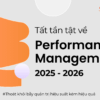
Currently, many companies have applied OKRs with free OKR software to manage their work effectively, but they have not been very successful and have faced many obstacles in the process of implementation.
Although OKRs used by free OKR software seem to be a simple framework on the surface, when implemented, few people succeed, practicing endlessly and still failing like a lesson, studying forever but not mastering.
Have you ever wondered why there are so many books, consultants, and free OKR software providers out there? It’s because OKRs are a continuous learning field that requires careful planning and management.
Today, Simplamo.com – free OKR software trial in 30 days, will share some of the most common OKR mistakes so that you can save time, avoid headaches, and quickly achieve the most successful OKRs.

Mistake 1: Overestimating your abilities, depends entirely on free OKR software, and not relying on actual measurement results
If you set unrealistic goals, your team may encounter some issues such as:
- Immediately realizing that the goal is not achievable.
- Losing morale because the goals make them lose confidence.
- Engaging in behaviors such as lying or shifting responsibilities to meet a goal.
The solution is to set realistic goals that are supported by data measured from past to present to predict the future. And Simplamo – a free OKR software trial in 30 days can help your company set realistic goals with our modern tools.
Mistake 2: Not understanding the essence of OKR and being completely dependent on free OKR software
One of the biggest mistakes when talking about OKR is that most of us do not understand the essential components that makeup OKR. If you do not understand the main components and their differences, you cannot effectively follow the OKR method. Even when using free OKR software.
OKR consists of two parts: Objectives and Key Results.
The objective needs to be inspiring, qualitative, and a declaration of your intention of what you want to achieve. On the other hand, Key Results are quantifiable and proven by measuring progress.
For each objective, there are usually 3-5 key results. Daily tasks are the activities you must complete to achieve those key results.
Mistake 3: Confusing KPIs and OKRs
Key Performance Indicators (KPIs) and Objectives and Key Results (OKRs) are related but serve different purposes.
In many cases, your KPIs will be the metrics used to determine key results.
For example, if your Objective (O) is “Create an unforgettable customer experience,” one of your Key Results (KRs) may be to increase customer satisfaction by 2 points after each interaction (KPI). Depending on your current focus, in many situations you may achieve your KPI but not be aligned with your Key Results (KR).
Mistake 4: Setting subjective OKRs from superiors, free OKR software, without teamwork input
One of the great things about OKRs is that they narrow the execution gap of strategy in an organization. As a leader, managers naturally have the strongest grasp of strategy, but they cannot keep track of all the details of daily execution. Free OKR software usually can’t have enough technology or doesn’t give you enough authority to do that.
So, when a manager sets OKRs for a team but is not aware of the details of the task execution of the members or simply has too many departments to oversee and relies completely on free OKR software. They can set unrealistic goals that may pose some challenges to achieving the results.
Additionally, managers may miss out on opportunities to drive employee engagement. In reality, it is best to set OKRs in collaboration with teamwork, nor should it all depend on free OKR software to ensure a unified, and effective implementation process.
Mistake 5: Not using software or just using free OKR software
There is an old saying that what does not advance will retreat, and applying technology is one of the clearest proofs of that.
If managers are running quick tests with OKRs, they can manage the process using tools like Google Sheets, Excel, or free OKR software. However, once the company requires a unified and long-term OKR setup, Excel, and free OKR software is completely inadequate in these situations. The company needs powerful software to make the OKR setup and implementation process smooth and effective. Without software, or just using free OKR software, it is a real challenge for the company’s development.
How software solves the practical problem of OKRs, something that free OKR software is difficult to completely satisfy:
- Access data to track progress and timely detect issues that could pose difficulties for OKRs
- Easily manage OKR execution and related tasks
- Create transparent, understandable, and clear OKRs – without this, it will be difficult to predict the business position and create noise during growth.
Therefore, software is needed to minimize noise points and create a predictable future, enhancing the resilience of businesses to market volatility risks. Even free OKR software can help solve that problem for your company, although that is not enough.
Simplamo – The comprehensive software to fix the top 5 most common OKR mistakes:
Simplamo.com is a modern business management software that can help companies achieve successful OKRs and easily overcome the 5 weaknesses. At Simplamo, any noise in a company’s OKRs will be addressed through simple but accurate steps that focus on the core issue. OKR pain when using free OKR software or unsuitable tools, is no longer a silent note in the high-soaring development of the company.
First and foremost, the most important factor in determining whether you will succeed with OKRs or not is clarity and specificity in the organizational structure because only clarity in positions leads to specific and decisive actions, which most free OKR software tools do not allow you to achieve. The boss is the boss and has his/her own tasks, and employees are different from managers, each with their own functions. “Know yourself, know your enemy, and you will win every battle” – Sun Tzu.
A common occurrence in Vietnamese companies is that bosses often take on the tasks of the team, making everything necessary to do, and it’s hard to explain, especially if it’s all invisible work. Sometimes, you want to know why you’re busy all day but can’t seem to get anything done. Employees are not proactive in their work, sometimes relying on everything being said orally, initially saying yes but then not paying attention to completing the task. Therefore, no matter how good your OKRs are, they will be difficult to implement. Even if the boss is a great leader, it’s not easy to accomplish everything.
The answer here is to find a responsibility chart that is easy to understand, but short and deep enough for the entire company. Tasks should not be placed in a spiritual, telepathic way to read and then deduce. Roles must be scientifically defined, easily understandable, and actionable without the need for any further interpretation.
On Simplamo, the Responsibility Chart feature specifically details the tasks for every job title in the company, from the top 5 core roles for each person and below, according to the standard US management model, arranged extremely scientifically, streamlined, and simple, helping to “minimize misunderstandings” in the team, all focused on the simplicity of theory and quickly taking action for their effectiveness.

Secondly, set the company’s core goals in 7 concise objectives, which all members will discuss. Each department and member will have clear and specific goals using the S.M.A.R.T. method. Especially for departments such as Marketing, Sales, Accounting, etc., the core objectives will be summarized in less than 7, using affirmative and measurable statements to reduce half-hearted work habits. Everyone will understand each other’s tasks clearly, and measure progress in detail based on completion timelines of all members and departments. All tasks will be managed on Simplamo – a free OKR software trial in 30 days.

Next is to set KPI indicators for each week on the Scorecard: OKR is not KPI, and this is easy to understand when using Simplamo – a free OKR software trial in 30 days. The indicators are calculated and discussed to measure the results each week in line with the Quarterly goals, while still allowing for flexibility in response to market fluctuations. Examples of indicators include quality metrics, quantity metrics, evaluation metrics, and so on. All of them are very specific and easy to understand. This helps to simplify the team’s work so that they can quickly get started and export files quickly and conveniently for printing reports.

The Weekly Meeting tool solves tons of broken sections in plan execution – an effective Weekly Meeting rhythm, with a pre-existing framework, 7 specific steps, all linked together and automatically creating issues when they arise continuously. Urgent issues will be added to the To-do list, and if they take longer, they will be listed in the Rock – the quarterly goal that needs to be completed. Each person will have a specific PIC, and the meeting will be alternately chaired by the middle management team to help them become stronger and not rely on the top boss.

On Simplamo, building annual goals, setting expected metrics for the team to aim for, and breaking them down into Quarterly Objectives and Key Results (OKRs) and specific KPIs for each role, are all focused on achieving a successful year through a smooth and simple operating process, as well as driving internal motivation towards long-term success.
In addition, Simplamo – a free OKR software trial in 30 days, also has a dedicated consulting team with a philosophy of prioritizing business growth, for a prosperous and thriving Vietnam. Simplamo.com is exactly what businesses are always looking for in a technology partner.
—————————————————
Simplamo is a modern and scientifically-based management software that uniquely combines KPI and OKR, making every aspect of operation simple and approachable for every employee. It relieves pressure for leaders, allowing them to focus on important missions and optimize work performance for the business.
Experience Simplamo and feel the change in just 4 weeks! Register for a Simplamo demo at: https://app.simplamo.com/sign-up













Recent Comments